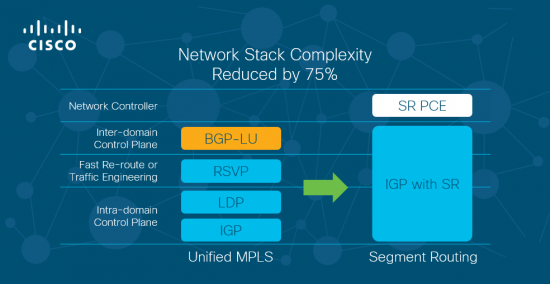































Segment Routing is the term widely used in the industry to refer to Source Packet Routing In Networking (SPRING), as defined by the Internet Engineering Task Force (IETF). Cisco has pioneered Segment Routing since 2012 and has led the standardization efforts with the support of a group of lead operators, resulting in 4 RFCs and over 50 active internet drafts.
With the explosive growth of network traffic, there is more pressure than ever on the network to operate with simplicity, speed, scale and resiliency. Since the emergence of Segment Routing (SR) five years ago, more and more customers have turned to this technology to help address the challenges of digitization and to accelerate the network transformation necessary to meet those challenges.
Numerous service providers, hyper-scale web providers and large enterprises have publicly reported Cisco SR deployments.

Industry analysts have also taken notice of the value that SR technology brings to customers:
"Service providers need to reduce current complexities in their networks to compete efficiently. For network owners there are only two options: either continue to grow with the complexities and lose more on CapEx and OpEx or think outside of the box with segment routing to solve these issues. This proven technology enables flexible network programming, the collapse of multiple layers and eliminates the need for overlay and additional protocols for service chaining. The result is that networks are simpler to run and operate, allowing providers to unlock new revenue potentials."
- Ray Mota, CEO ACG Research
What are the key business benefits of adopting Segment Routing technology?
OpEx reduction
Over the past decade, the range of services delivered by service providers has significantly expanded in scope -from voice and data centric services to a multitude of higher value offerings and services, including broadcast video, video streaming, augmented reality and more. These newer services have required a transformation of the underlying network infrastructure.
WAN networks have manifested an increasing level of complexity, with protocols and solutions being added over decades to the network, elevating levels of operational spend to keep the network functional. With these newer services, such complexity is counter to the desired business outcomes.
The time for simplification has come -and it starts with reducing the networking stack complexity, e.g. cutting out as many unnecessary protocols as possible.
Segment Routing brings simplification at multiple layers of this stack.
Segment Routing can reduce networking stack complexity by 75 percent
-from four different protocols to one.

First, by using extensions to existing routing protocols, such as IS-IS and OSPF, for signaling purposes, SR eliminates the need to use a dedicated signaling protocol such as Label Distribution Protocol (LDP). Relying on standard routing protocols allows the network to take advantage of Equal Cost Multi-Path Routing (ECMP) to load balance across multiple available paths and gain better bandwidth utilization.
SR also makes traffic engineering simple and scalable by eliminating the RSVP TE protocol, avoiding the scalability limits observed outside of Core network use cases. SR TE is highly scalable, as state is only maintained at the edge of the network. Moreover, the on-demand policy makes traffic engineering simple, automatic and lightweight. (This contrasts with RSVP-TE and its need to have policies preconfigured along with complex tunnel configurations.) This is a traffic engineering revolution in terms of scale and simplicity.
Lastly, the insertion of an SR Path Computation Element (SR PCE) makes Segment Routing function across network domains, thus eliminating the need to use the BGP Label Unicast protocol (BGP-LU).
This streamlined networking stack not only simplifies the delivery of services but greatly contributes to making network operations leaner and more efficient, resulting in significant OpEx savings.
Reduced financial liabilities
Service Level Agreements (SLAs) are deeply entrenched in service provider (SP) offerings. They define the level of service customers expect from SPs, laying out the metrics by which the service is measured as well as remedies or penalties should service levels not be achieved. A common one is the Service Availability Metric, which depends on, among other things, network availability.
In that respect, a standard network requirement is to have failure recovery in less than 50 milliseconds. Segment Routing offers a fast, simple and predictable recovery mechanism -Topology Independent Loop Free Alternate (TI-LFA) -that can provide loop-free guaranteed resiliency against link, node and local SRLG failures in all cases.No other existing solution offers that today.
Segment Routing can also prevent the occurrence of micro-loops. This well-known root IP problem happens when multiple networking devices do not update their forwarding tables simultaneously. It is a transient problem but one that can affect critical customer traffic, leading to potential financial damages due to traffic loss.SR brings the first practical solution to such micro-loops since the advent of routed IP networks.
Thanks to automated TI-LFA and micro-loop avoidance, Segment Routing facilitates unmatched network availability. It plays a key role in ensuring compliance with contractual SLAs, thus helping Service Providers reduce financial penalties and improve customer satisfaction.
New revenue streams & customer lifetime value
Service providers are seeking to extract more value from their network infrastructures. With Segment Routing, they can offer innovative and differentiated network services delivering top-line growth to their businesses. Low-latency and disjointed network services are the ones most in demand: low-latency network service ensures that time-sensitive applications are always directed over the optimal low-latency path; and disjointed network service ensures that applications can be directed over two paths, independent of one another, to provide higher resiliency in case of network failure.
With the advent of 5G services, service providers plan to offer custom fit network slicing services to support specific customer applications. Segment Routing provides two key capabilities in this regard:
In addition to enabling new service delivery, Segment Routing contributes to delivering a better end-user experience. Alibaba Group's Chief Network Architect Dennis Cai explained this at the Sigcomm 2017 conference:
"Alibaba Group's mission is to make it easy to do business anywhere. We put special focus on having network infrastructures capable of supporting this mission. In that respect, Segment Routing architecture brings us many benefits -first, it can be easily deployed in our existing network infrastructure; second, the ability to have fine-grain control over how the network transports applications while being stateless meets our elasticity requirements. It helps us to deliver a better end-user experience."
The end-user experience is particularly important as it increases customer satisfaction that, in turn, is positively correlated to higher Customer Lifetime Value (CLV). Offering new network services and driving up CLV increases both short and long-term revenues for carriers.
By delivering tangible business outcomes, Segment Routing appeals to many key stakeholders:
It is clear that any successful digital business strategy must be powered by the right technology. Segment Routing can play an important role in transforming networks to meet challenging operational and business demands while also enhancing the customer and end-user experience.
To stay up-to-date on SR innovations, visit our Segment Routing website.
@jonathandavidsn
 Etiquetas calientes:
service providers
segment routing
service provider networking
Etiquetas calientes:
service providers
segment routing
service provider networking